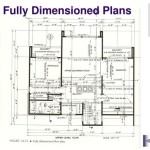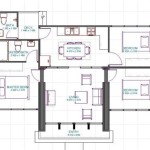Make My Own House Plans: A Comprehensive Guide
Designing a home is a significant undertaking, requiring careful consideration of numerous factors, including personal needs, lifestyle, budget, and adherence to building codes. While engaging an architect or professional designer is a common approach, creating house plans independently is a viable option for individuals with a blend of design sensibility, technical aptitude, and a commitment to thorough research.
This article explores the process of developing house plans independently, outlining essential steps, tools, and considerations to ensure a successful outcome. The information provided aims to empower individuals to navigate the complexities of house plan creation, enabling them to realize their vision of a personalized and functional living space.
Understanding Fundamental Requirements
Before embarking on the drawing process, it is crucial to establish a solid foundation of knowledge and understanding. This involves several key areas, including building codes, site assessment, and defining functional space requirements.
Building codes are a set of regulations established by local and national authorities to ensure the safety and structural integrity of buildings. These codes dictate various aspects of construction, including minimum room sizes, egress requirements, fire safety measures, and accessibility standards. Failure to comply with building codes can result in delays, fines, and even the rejection of the building permit application. It is imperative to consult the relevant local building codes and familiarize oneself with the specific requirements applicable to the project's location.
Site assessment involves evaluating the physical characteristics of the building site. This includes factors such as the topography, soil conditions, drainage patterns, and orientation relative to the sun and prevailing winds. Understanding these factors is essential for optimizing the design to maximize energy efficiency, minimize environmental impact, and ensure proper drainage. For example, the orientation of the house can be optimized to maximize solar gain in the winter and minimize it in the summer, reducing heating and cooling costs. Similarly, understanding soil conditions is crucial for designing a stable foundation that can withstand the weight of the building.
Defining functional space requirements is a critical step in the design process. This involves determining the size and layout of each room, as well as the overall flow and functionality of the house. Consider the number of bedrooms and bathrooms needed, the size of the kitchen and living areas, and any special requirements such as a home office, workshop, or playroom. It is also important to consider the storage needs of the household and ensure that adequate storage space is provided throughout the house. A detailed needs assessment can help to avoid costly mistakes later in the design process.
Selecting the Right Tools and Software
The tools used to create house plans have evolved significantly over time. While traditional drafting methods using pencils, rulers, and drafting tables are still employed by some, computer-aided design (CAD) software has become the industry standard due to its precision, efficiency, and ability to create detailed and accurate drawings.
CAD software offers a wide range of features, including the ability to create 2D and 3D models, generate detailed construction documents, and simulate various design scenarios. Several CAD software options are available, ranging from free and open-source programs to professional-grade applications. Popular choices include AutoCAD, SketchUp, Revit, and Chief Architect. Each software package has its own strengths and weaknesses, so it is important to carefully consider the specific needs of the project and choose a software package that is appropriate for the task.
For beginners, SketchUp is often recommended due to its user-friendly interface and relatively short learning curve. It allows for easy creation of 3D models and is suitable for visualizing the overall design of the house. AutoCAD, on the other hand, is a more powerful and versatile software package that is widely used by architects and engineers. It offers a greater level of precision and control, but it also requires a more significant investment of time and effort to learn. Revit is a Building Information Modeling (BIM) software that allows for the creation of intelligent 3D models that contain information about the building's components, such as materials, dimensions, and energy performance. Chief Architect is specifically designed for residential design and offers a wide range of features tailored to the needs of home designers.
In addition to CAD software, other tools can be helpful in the house plan creation process. These include measuring tapes, laser levels, and digital cameras. Measuring tapes are essential for accurately measuring the dimensions of the building site and existing structures. Laser levels can be used to ensure that surfaces are level and plumb, which is crucial for accurate construction. Digital cameras can be used to document the existing conditions of the site and to take photographs of design inspiration.
Drawing the House Plans: Step-by-Step Process
The actual drawing of the house plans involves a systematic approach, starting with the conceptual design and progressing to detailed construction documents. The process typically involves the following steps:
Conceptual Design: This is the initial phase of the design process, where the overall layout and appearance of the house are determined. This involves sketching out various floor plans, considering the flow of traffic, the placement of rooms, and the overall aesthetic. It is important to experiment with different layouts and consider the advantages and disadvantages of each option. The conceptual design should also take into account the specific needs and preferences of the homeowners, as well as the constraints of the building site and budget.
Floor Plans: Once the conceptual design is finalized, the next step is to create detailed floor plans. This involves drawing the walls, doors, windows, and other architectural features to scale. The floor plans should also include dimensions, room names, and the location of electrical outlets, switches, and plumbing fixtures. It is important to pay close attention to detail and ensure that the floor plans are accurate and complete. This will help to avoid costly mistakes during construction.
Elevations: Elevations are drawings that show the exterior appearance of the house from different viewpoints. Typically, four elevations are created, showing the front, back, and sides of the house. The elevations should include details such as the roofline, windows, doors, and exterior finishes. They provide a visual representation of the house and help to ensure that the design is aesthetically pleasing.
Foundation Plan: The foundation plan shows the layout of the foundation, including the footings, foundation walls, and any supporting piers or columns. It is crucial for ensuring the structural integrity of the house. The foundation plan should be designed in accordance with local building codes and should take into account the soil conditions of the building site. It is often advisable to consult with a structural engineer to ensure that the foundation plan is adequate for the intended use.
Roof Plan: The roof plan shows the shape and slope of the roof, as well as the location of any roof features such as chimneys, skylights, and vents. The roof plan should be designed to effectively shed water and snow and to provide adequate ventilation for the attic space. The roof design should also be aesthetically pleasing and should complement the overall design of the house.
Electrical Plan: The electrical plan shows the location of all electrical outlets, switches, lights, and other electrical fixtures. It is important to ensure that the electrical plan is designed in accordance with local building codes and that it provides adequate electrical capacity for the intended use. The electrical plan should also take into account the specific needs of the homeowners, such as the location of computers, televisions, and other electronic devices.
Plumbing Plan: The plumbing plan shows the location of all plumbing fixtures, such as sinks, toilets, showers, and bathtubs, as well as the location of water supply lines and drain lines. It is important to ensure that the plumbing plan is designed in accordance with local building codes and that it provides adequate water pressure and drainage capacity. The plumbing plan should also take into account the specific needs of the homeowners, such as the location of washing machines, dishwashers, and other appliances.
Construction Details: Construction details are enlarged drawings that show specific aspects of the construction, such as wall sections, window details, and door details. They provide detailed information about the materials and construction methods that are to be used. Construction details are essential for ensuring that the house is built to the required standards and that it is structurally sound.
Navigating Building Codes and Permits
Obtaining the necessary building permits is a crucial step in the house building process. Building permits are required to ensure that the construction is in compliance with local building codes and regulations. The process of obtaining building permits can be complex and time-consuming, so it is important to be prepared and to understand the requirements of the local authorities.
The first step in obtaining a building permit is to submit a set of house plans to the local building department. The house plans must be detailed and accurate and must comply with all applicable building codes. The building department will review the plans to ensure that they meet the requirements of the codes. If the plans are approved, the building permit will be issued.
In some cases, it may be necessary to obtain other permits in addition to the building permit. These may include permits for electrical work, plumbing work, or mechanical work. It is important to check with the local authorities to determine which permits are required for the project.
The building department may also require inspections at various stages of the construction process. These inspections are conducted to ensure that the construction is being performed in accordance with the approved plans and building codes. It is important to schedule these inspections in advance and to be prepared for the inspector to visit the site.
Failure to obtain the necessary building permits or to comply with building codes can result in significant penalties, including fines, delays, and even the demolition of the building. It is therefore essential to take the building permit process seriously and to ensure that all requirements are met.
For individuals unfamiliar with the intricacies of building codes and permit requirements, seeking guidance from a qualified building inspector or consultant is recommended. This professional can provide valuable assistance in navigating the regulatory landscape and ensuring compliance with all applicable requirements.

House Plans How To Design Your Home Plan

House Plans How To Design Your Home Plan

House Plans How To Design Your Home Plan

Designing My Own House

House Plans How To Design Your Home Plan

House Plans How To Design Your Home Plan

House Plans And Design

Floor Plan Creator And Designer Free Easy App

House Plans How To Design Your Home Plan

Floor Plan Creator And Designer Free Easy App
Related Posts








